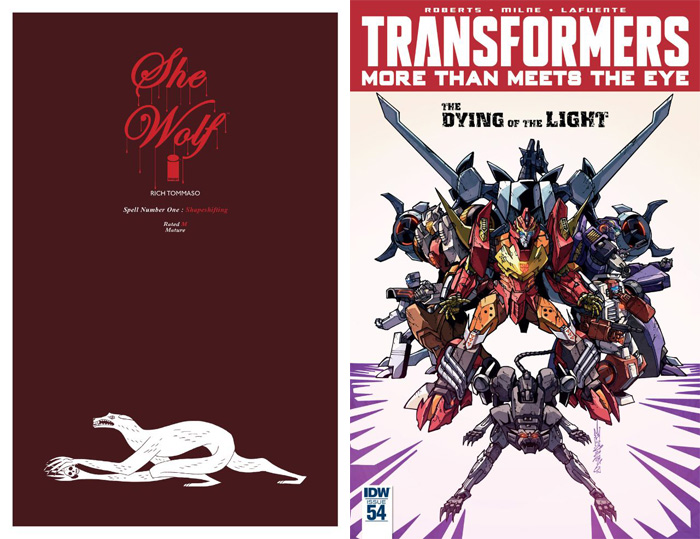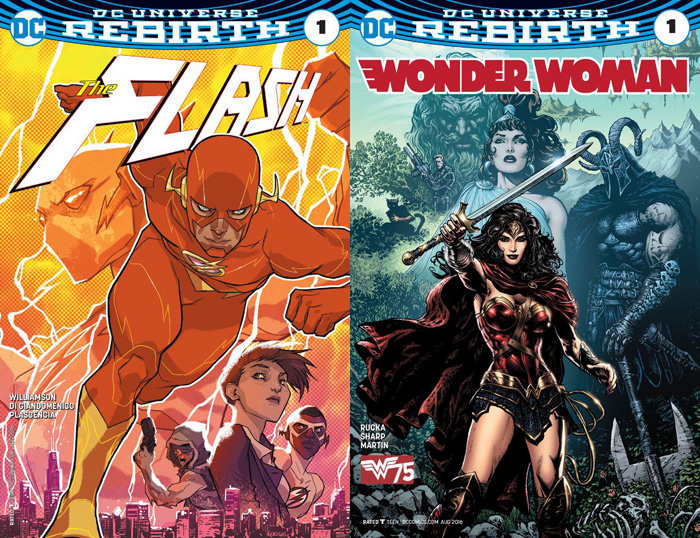Deadshirt Is Reading… is a weekly feature in which Deadshirt’s staff, contributing writers, and friends-of-the-site offer their thoughts on Big Two cape titles, creator-owned books, webcomics and more.
Sarah Register is reading…
She Wolf #1
Story and Art by Rich Tommaso
Image Comics
“You were involved in a killing. You’re a bad girl…”
She Wolf is a fast-paced fever dream that feels unlike any issue #1 I’ve read in recent memory. Gabby, a high school student who dresses like the ladies from The Craft, is scratched by her lycanthropic boyfriend, and the story takes off into a surreal sense of panic as she constantly wakes up from one nightmare into the next. Neither Gabby nor the reader knows what is real and what isn’t as dreams blend with reality and the heroine develops a bloodlust on top of her daily struggles as a teenage girl.
The interesting thing about this premiere issue is that it doesn’t feel like a comic issue in the traditional installment sense. Tommaso’s limited dialogue combined with the effect of stringing Gabby’s dreams together make the comic feel like a series of vignettes that link the events on the first page to the last. Referring to the first issue as the first “spell” works with this idea, especially when you think of spell as both a magical thing and a period of time.
Likewise, Tommaso’s stylized artwork feels as experimental as his storytelling. Mixing retro pop with a 2 dimensional style you might see in a pre-Renaissance triptych, the pages tend to give you a sense of deja vu without feeling like a direct copy of anything. Sometimes, however, the characters can feel a little stiff, especially Gabby, who has the same facial expression in almost every panel.
If you’re looking for something different, She Wolf is a chilling remedy for comic book fatigue that may shine a little brighter as a collected volume.
Patrick Stinson is reading…
Transformers: More Than Meets The Eye #54
Written by James Roberts
Art by Alex Milne
Colors by Joana LaFuente
“You were right, Overlord…without his gun he is nothing.”
“The Dying of the Light: Part Five” is the penultimate issue of the closing arc of this “Season” of More Than Meets The Eye. This means a couple of things — it’s an unusually action-packed issue for this series, with Milne delivering some of his best work to date; and Roberts’s famous array of Chekhov’s Guns is firing off with a battalion’s worth of foreshadowed firepower. (As if that wasn’t enough, a key moment in this issue pays off a relationship that was established in Marvel Transformers #1 — in 1984.)
We last left our heroes, led by Rodimus, charging into hopeless odds. The core cast was abandoned by the crew of the Lost Light for their acceptance of the redeemed pacifist Megatron, and they are now at the mercy of a Decepticon army led by Megatron’s deranged proteges, the Decepticon Justice Division. In previous issues the villainous Overlord and the heroic Drift and Ratchet arrived on the planet to back up their respective factions, contributing to the feeling of closure in the book and an upcoming seachange. At the beginning of this issue, we learn that Rodimus’s crew has made some adjustments to give them a fighting chance, but at the cost of one of their dwindling shipmates. It’s still not enough, and this is Butch and Sundance against the Bolivian Army, just deferred. (Not even this trope goes unexamined by Roberts, with Decepticon commander Deathsaurus agonized by the deaths of his troops.)
Megatron hangs back. His fear is that if he so much as throws a punch, he will be reborn as the architect of millions more years of galactic war. Roberts has fully committed to this idea despite it being a tie-in to a bunch of shoot-em-up toy robots. A lesser writer would use a lapse in Megatron’s pacifism as the deus ex machina of this storyline and let him angst about it later. What happens is far more cruel, and born from the inescapable logic that our proteges will one day surpass us. Megatron’s personal struggle may be lost, and Roberts makes us complicit, tempted by his moral failure, only for this moral failure to lead to other failures that cheat us of our satisfaction.
A more classical tragedy plays out with the characters of Skids and Brainstorm, connected by a crime that neither of them know about until one’s final seconds. While the resolution of this long-running bit of dramatic irony feels a bit cheated for space, it is strengthened by tying it into Megatron’s story. Megatron could have prevented a death, but failed. Of course, Megatron could have prevented all the deaths, but has always failed. In a universe where characters are defined by what they transform into, it’s appropriate to ask whether Megatron would have been, could have been, anything more than a gun.
Joe Stando is reading…
The Flash #1
Written by Joshua Williamson
Art by Carmine Di Giandomenico and Ivan Plascencia (colors)
Lettered by Steve Wands
DC Comics
“I can never stay in one place too long… not when there’s so much to be done.”
I was interested in this arc based on the press materials for it, which included a new speedster called Godspeed. I’m pretty in the bag for Flash rivals and Rebirth stuff in general, so I decided to check it out. And it’s… underwhelming.
Not artistically, mind you. Di Giandomenico has a great eye for motion and the kind of kinetic pop you need in a Flash story. There’s not quite the cleverness in layout of some of the best Manapul days, but it’s a fast, dynamic read, particularly in panels indicative of greater motion, like Barry donning his Flash outfit. Artistically, I’m still sold.
But everything about the storyline feels so boilerplate. I get that Rebirth, like most rebrandings of the past few years, is a jumping on point, and maybe if this was your first Flash story, it’d be great. But I felt like most of it has been done better in both Johns’s run with the character and the eponymous TV series. The aforementioned Godspeed doesn’t get his origin until the final page, which is understandable as serialized storytelling but disappointing when he’s the selling point.
It’s funny, both Flash and Batman are telling “new hero in town” stories, and both of them structured theirs similarly: illustrate the nature of the hero and his limitations, and then show a new character who could transcend them. But while Batman #1 tells an incredibly compelling standalone story to get to that point, Flash just rehashes basic character beats for an entire issue. It’s not an awful issue, even. It’s just way too familiar.
Adam Pelta-Pauls is reading…
Wonder Woman #1
Written by Greg Rucka
Art by Liam Sharp
Colors by Laura Martin
Letters by Jodi Wynne
DC Comics
“I have come to ask your goddess for aid. I will not leave until I have her answer.”
Greg Rucka’s return to Wonder Woman was one of the bombshells at the DC Rebirth launch: a big name on one of their Big Three characters. Additionally, it was probably a way to assuage the fears of longtime readers scarred by The New 52 by putting a familiar face on a flagship title. Rucka’s previous run with the daughter of Hippolyta has near-universal acclaim, and frankly no Wonder Woman arc since then has been quite as good. Grant Morrison’s Earth One run might come close, but that’s an argument for another time.
If you read her Rebirth issue, this #1 picks up the same thread: Diana is trying to make sense of the “lies” of the New 52 universe. Her memories are a jumble of conflicting timelines, and it’s clear from page one that she’s looking for help. Her search has taken her to a Bwundan rainforest in the heart of Africa, where she fends off hyena monsters while seeking some unexpected aid. At the same time, Steve Trevor is also in Bwunda on a separate mission, tracking down a warlord, while his handler, Etta Candy, keeps tabs on him from a secret base in Langley, VA. The fact that they’re in the same country is purely coincidental, but Diana’s presence in Bwunda raises red flags and eyebrows for Etta, who worries whether Trevor might have leaked mission details to her. Of course, Wonder Woman isn’t there for some petty warlord; she’s lost Themyscira. And she needs Cheetah’s help to find it!
As first issues go, this one is fairly enigmatic. But I keep reminding myself that it’s only half the project. Rucka is also writing a Year One story for her, and that’s honestly the part of this I’m more excited about. Rucka does best when he draws from the deep wells of a character’s backstory, and I’m hoping for a little Golden Age Wonder Woman weirdness out of it. Luckily, I’ll only have to wait three weeks to read that. It’ll be six before I figure out what’s going on here!
That said, though, I really am surprised DC isn’t making a bigger deal out of Wonder Woman’s 75th year of publication. She’s one of their biggest sellers, and arguably the most easily recognizable female superhero, except maybe Sailor Moon. For a character that was created as an example of the way comics can be used to teach readers (in her case, about feminism and female liberation), Wonder Woman has endured in a way many female characters haven’t. That she remains a standard-bearer for DC is testament to what she’s meant to generations of comic book readers for three quarters of a century now. So where’s the fanfare? Apart from the little “WW75” stamp in the corner of the cover, you wouldn’t know it was such an exciting time to be a Wonder Woman fan. I’m excited to see this series live up to that legacy, but come on, DC! Be a little louder and prouder about it!
Thanks for reading about what we’re reading! We’ll be back next week with a slew of suggestions from across the comics spectrum. In the meantime, what are you reading? Tell us in the comments section, on Twitter or on our Facebook Page!



